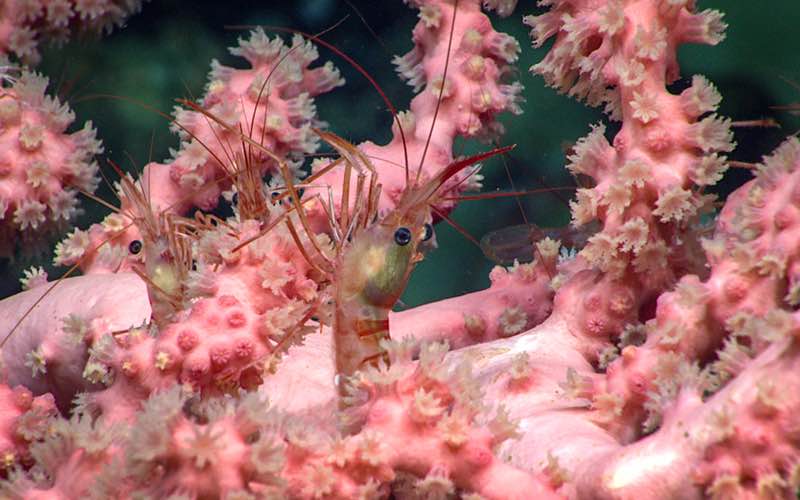
Protected ocean areas, like the Canyons and Seamounts Marine National Monument, can have a tremendous impact in our lives and the environment. Here are five reason to protect more of our ocean. Photo: NOAA Office of Ocean Exploration and Research, Deep Connections 2019
Just 130 miles off New England’s coast, in the depths of the ocean, lies the Northeast Canyons and Seamounts Marine National Monument – an underwater treasure teeming with life and color. The Canyons and Seamounts provides a home to ancient deep-sea corals, charismatic seabirds, endangered mammals, and many rare species.
In addition to its marvelous underwater sights, this majestic place fosters a healthy marine ecosystem. And the protections afforded by the monument designation help build the ecosystem’s resilience to the impacts of climate change.
The Canyons and Seamounts is the very first and only marine national monument in the U.S. Atlantic Ocean – a designation CLF and our partners played a key role in. But it shouldn’t be the last.
We must protect more special places in New England’s ocean. Here are five reasons why:
#1 Highly protected areas help ocean habitats to recover
From deep-sea corals to luminous estuaries, New England has some fantastic and unique ocean habitats. But human activities and rising ocean temperatures have profound impacts on our ocean and coasts and the diverse wildlife they support. Protecting these important ecological areas from harm could help them recover from disturbance and better support marine life. Healthier habitats, in turn, can better support tourism, fishing, recreation, and other human activities.
#2 Highly protected areas can help restore New England’s historic fisheries
New England currently has 16 fish populations classified as overfished – more than twice that of any other region in the country. Some of these species, like Atlantic cod and yellowtail flounder, have been overfished for decades. These fish species need to be sustainably managed. They also need places safe from human activity where they can feed, reproduce, and grow back their populations to healthy levels. For a species like Atlantic cod, protecting its habitat could make the difference between its recovery or collapse. This is vital, especially for our coastal communities that depend on healthy fisheries.
#3 Highly protected areas lessen the impacts of climate change
Research shows that highly protected areas support an abundance and diversity of species and make the ocean more resilient to climate change.
Highly protected areas also improve the ocean’s ability to absorb climate-damaging emissions – like carbon dioxide – from the atmosphere. This is, in part, thanks to many of the animals protected by these areas – like whales – whose bodies remove tons of carbon from the atmosphere throughout their lives.
On top of this, protecting special places like salt marshes and seagrass beds – which capture high levels of carbon dioxide and make water less acidic – helps ecosystems adapt to the negative effects of climate change.
#4 Highly protected areas benefit the economy
Not only are highly protected areas in our ocean good for marine wildlife and habitats, but they can also provide economic benefits by enhancing fisheries, increasing tourism revenue, and generating jobs. One study showed that every $1 invested in a marine protected area returns approximately $20 in benefits.
Worldwide, scientists have also found that highly protected areas can benefit fisheries in adjacent areas through the spill-over effect – a phenomenon that occurs when the increased abundance of fish in a protected area extends beyond (or spills over) its boundaries.
#5 Highly protected areas create opportunities for research
Human activities have drastically altered nearly two-thirds of the ocean. But highly protected areas that are safe from extractive and other destructive activities can help keep our ocean ecosystems intact. That also makes these areas excellent reference points for research.
For example, in New England, the Canyons and Seamounts monument makes for an excellent scientific reference site for studying the impacts of human activities and climate change on our ocean. Ocean managers, in turn, can leverage this information to make better and more sustainable decisions to plan for the future of these ecosystems.
We need to protect more of New England’s ocean
CLF has fought for decades to restore and protect New England’s ocean and the wildlife that call it home. With your help, we fought successfully for the designation of the Northeast Canyons and Seamounts Marine National Monument.
Now, President Biden has committed to conserving 30% of the nation’s lands and waters by 2030. We will continue working to ensure the administration protects more areas of New England’s ocean as part of this nationwide goal. You can help. Stay tuned for upcoming opportunities to make your voice heard and urge the government to create more protected areas throughout our country’s ocean.



